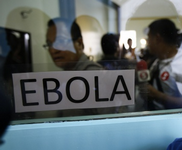
In a very topical Peter Rose Biotechnology Annual Lecture, Dr Felicity J Burt presented Ebola Detection and Discovery: a talk on Ebola and other haemorrhagic fevers.
A first responder in cases of haemorrhagic fever outbreaks, Dr Burt has travelled to several outbreaks of these diseases, and along with her research group has developed an understanding of what Viral Haemorrhagic Fevers (VHF) are, and how they work.
Working as a researcher in this arena is not a simple matter. Ebola has to be handled within the confines of a maximum containment laboratory, such as the BSL4 Laboratory in Johannesburg. BSL stands for Biosafety Level, and Level 4 is the highest security. Workers in these labs wear all-enclosing plastic suits, receive oxygen via a tube and have to have a chemical shower as they leave the facility.
Ebola is extensively in the public eye at present, however there are a number of VHFs which are seen fairly regularly, among them Rift Valley and Crimean Congo Fever, both of which, unlike Ebola, are endemic to South Africa. The VHF viruses are grouped according to the way they are transmitted; for example rodent-borne i.e. Lassa and Hantaan and arthropod-borne, such as Rift Valley and yellow fever. There are haemorrhagic viruses, such as Ebola, where scientists are unsure of the route the virus takes from the reservoir host, in this case bats, to infecting human and non-human primates. Dr Burt pointed out that five viruses are recognised as Ebola viruses, some more pathogenic than others.
The current outbreak of Ebola is the largest ever recorded. How can such outbreaks be controlled? Firstly, says Dr Burt, the source and the vector have to be identified so that the transmission chain can be broken. Ebola RNA has been detected in several bat species; there is low virus genetic diversity observed with person to person transmissions during human outbreaks.
Fruit bats are considered reservoir hosts. Ebola outbreaks tend to start in villages, with the disease spreading to family members of the patient. When the virus reaches hospitals, with a larger population of people and insufficient hygiene procedures, it spreads faster. There is no certainty as to how it is contracted, but it appears, says Dr Burt, to be spread through contact with blood and other body fluids from patients, or via dead monkeys which are then eaten. Non-human primates are not a reservoir source but an accidental host like humans.
People who have signs of the illness can transmit it; it has an incubation period of 7-10 days and, Dr Burt assures, unless a person is showing symptoms, they are not infections. Only after 42 days without a new case can an outbreak be declared over.
People who have close contact with infected human or non-human primates are at risk of contracting the virus. As a health care worker, the correct use of Personal Protective Equipment (PPE) is vital and health care workers and researchers often use the buddy system to second check possible exposure amongst themselves. There is a vital need to educate people about suitable burial ceremonies for those who have died of the disease. Most of the treatment available for Ebola is supportive.
Despite Ebola garnering headlines, it is not endemic here in SA, whereas Crimean-Congo fever, which is tick-borne, is. Small vertebrates are the reservoirs for this virus, and humans are accidental hosts, however it is pathogenic in humans and mice alone. Transmission is through contact with infected blood or other tissues of livestock or human patients, or from tickbite. Crimean-Congo Fever has a 30% fatality rate in SA and there have been just over 200 cases confirmed since 1981, when it was first identified in SA in a young boy who got it while at a Veldschool.
Dr Burt is working on research which sees the application of biotechnology (recombintant antigens are widely used) in diagnosis, discovery and vaccine development for VHFs. In terms of Ebola, researchers are working on developing vaccines, which have gone into phase 1 (human) clinical trials. The research will also look into whether immunoglobulin from survivors can be used as a treatment.
By Jeannie Mckeown
